Abstract
Anorexia, epigastric discomfort, nausea, and vomiting may result from disordered gastric motility and emptying. These features have been found in many adults with anorexia nervosa, but have never been investigated in early onset anorexia nervosa. In 14 patients with early onset anorexia nervosa (eight of whom had upper gastrointestinal tract symptoms), six children with other eating disorders, four children with non-ulcer dyspepsia, and 10 controls matched for age and sex, the non-invasive technique of surface electrogastrography was used to measure fasting and postprandial gastric antral electrical control activity, which underlies antral motility. The electrical signal was recorded by four bipolar silver/silver chloride electrodes attached to the upper abdomen, amplified and low pass filtered at 0.33 Hz before being displayed on a polygraph, digitised at 1 Hz, and stored on the hard disk of a personal computer for later offline analysis. Patients with non-ulcer dyspepsia had gastric antral dysrhythmias. No significant difference was found in the mean (SD) dominant frequency of the antral electrical control activity between patients with early onset anorexia nervosa (2.86 (0.35) cycles/minute (cpm)), patients with other eating disorders (3.14 (0.65) cpm), and controls (3.00 (0.46) cpm). The amplitude of electrical control activity increased postprandially in all but one subject and the fasting/postprandial amplitude ratio did not significantly differ between patients with early onset anorexia nervosa and controls, though patients with longer established disease had a smaller increase in amplitude. Gastric antral electrical dysrhythmias are not a feature of early onset anorexia nervosa and therefore do not induce or perpetuate food refusal in this disorder.
Full text
PDF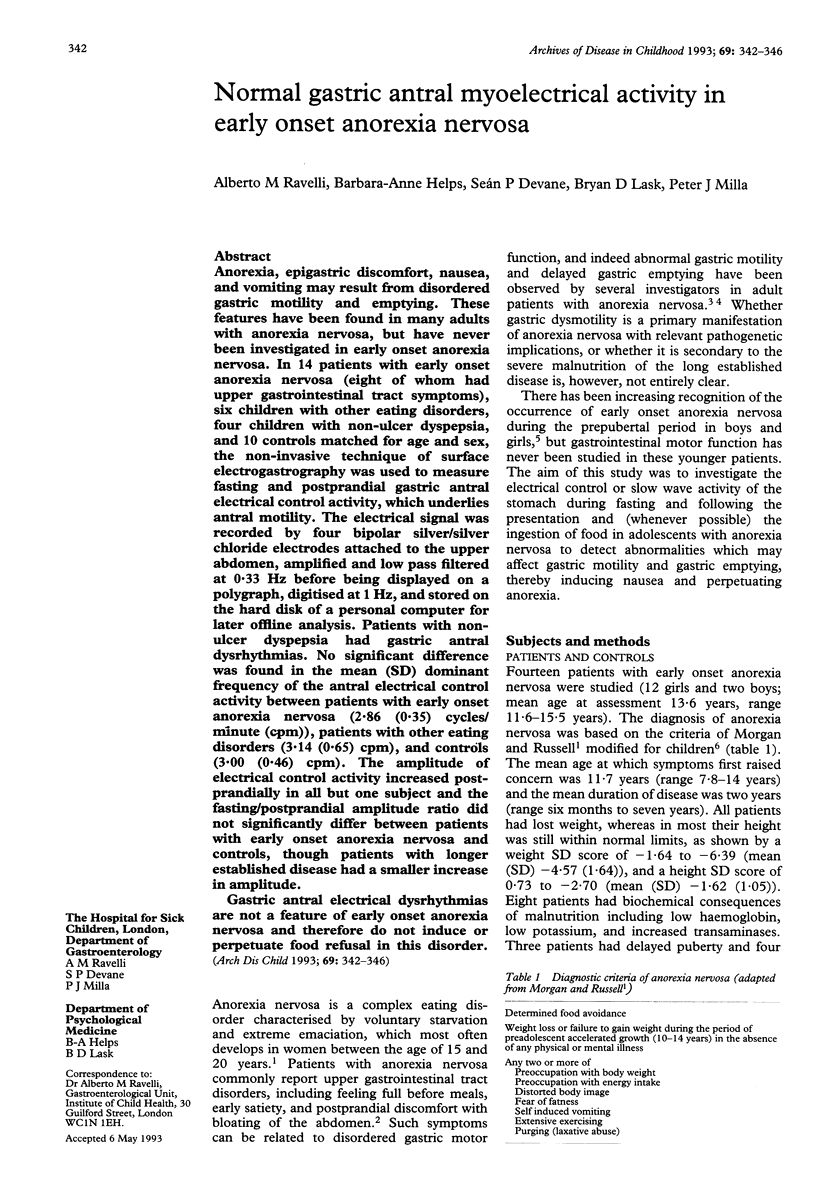
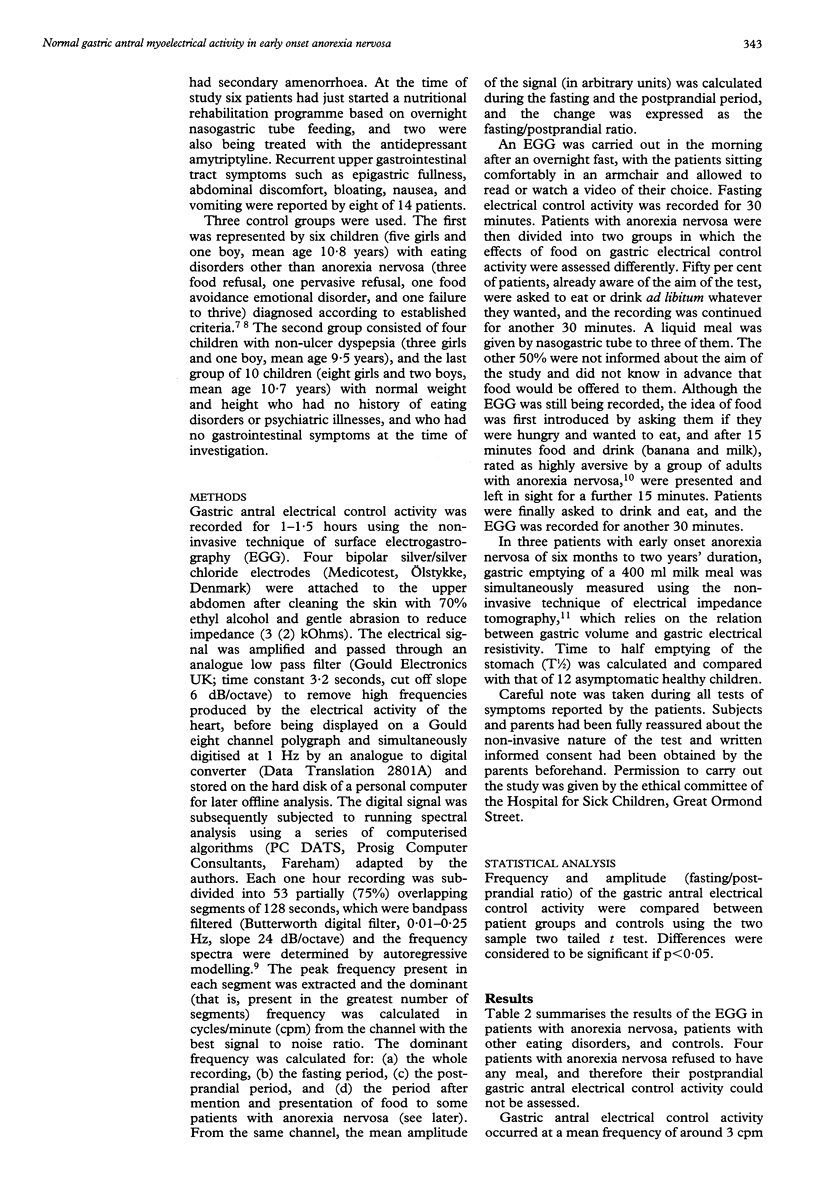
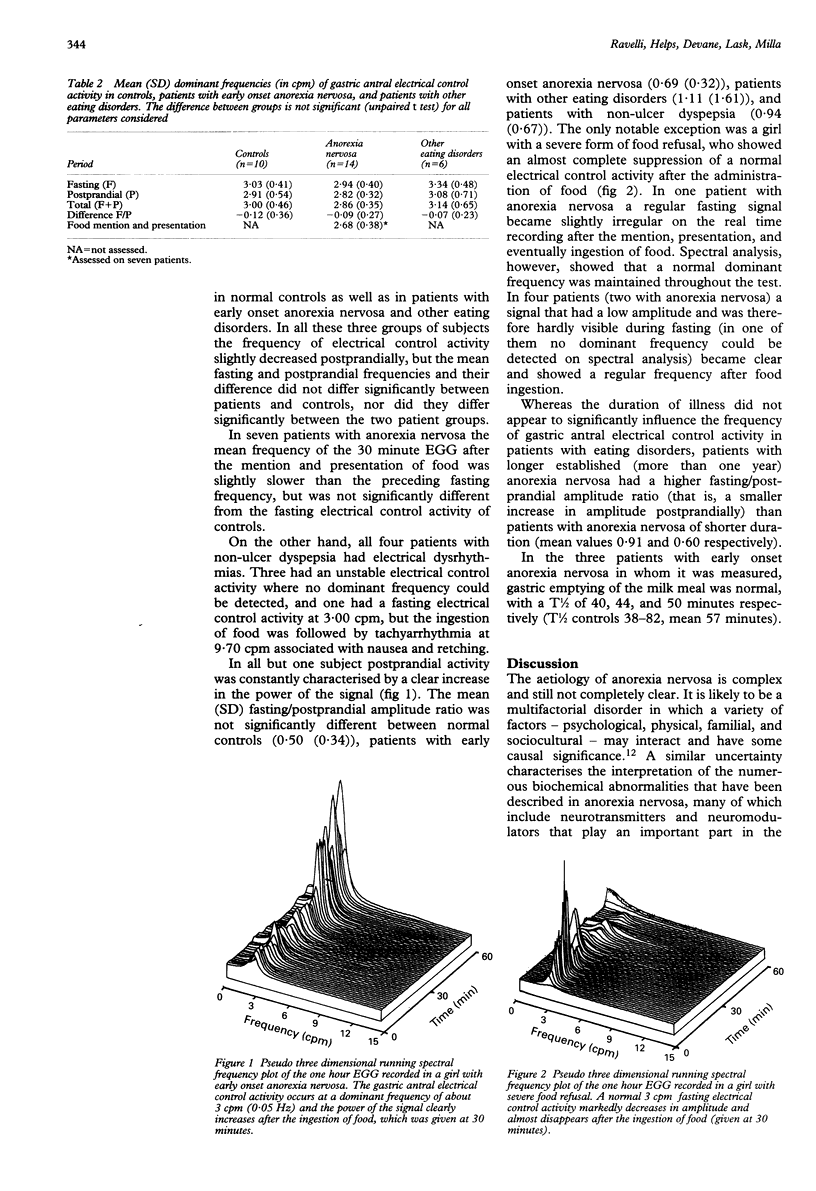
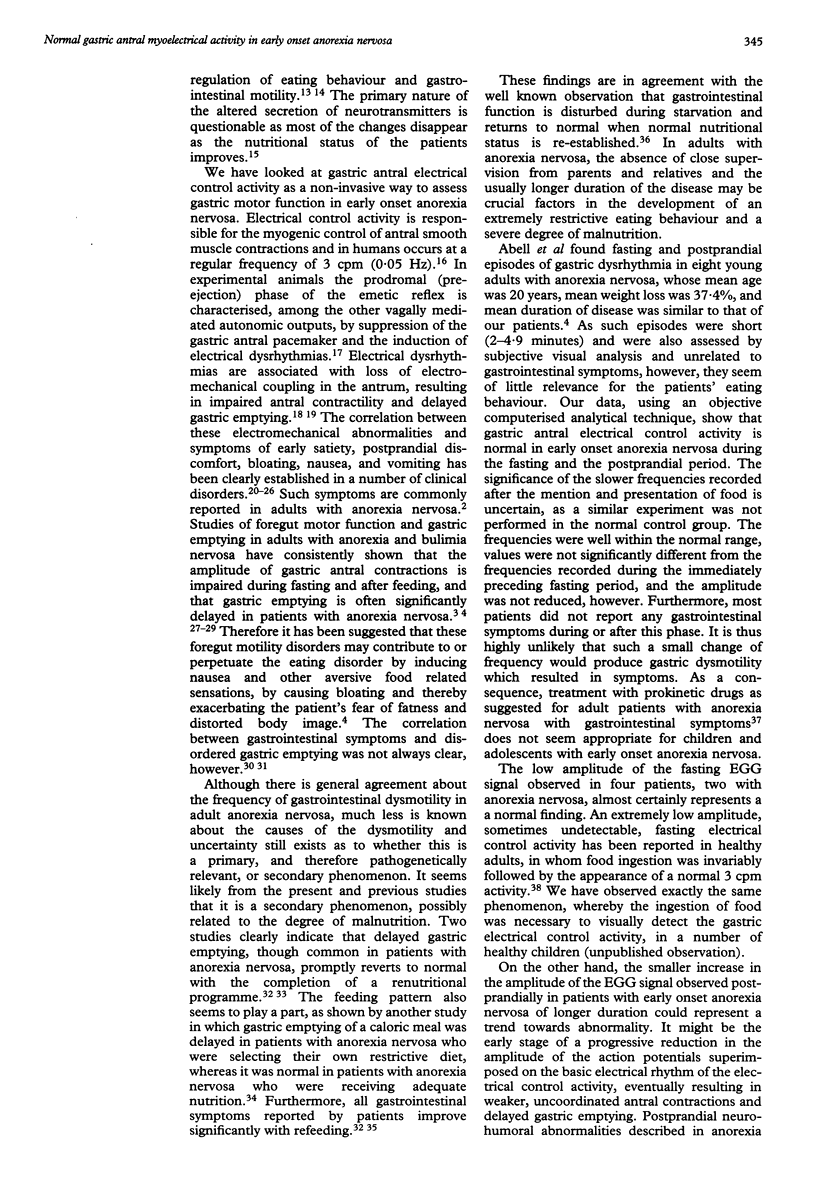
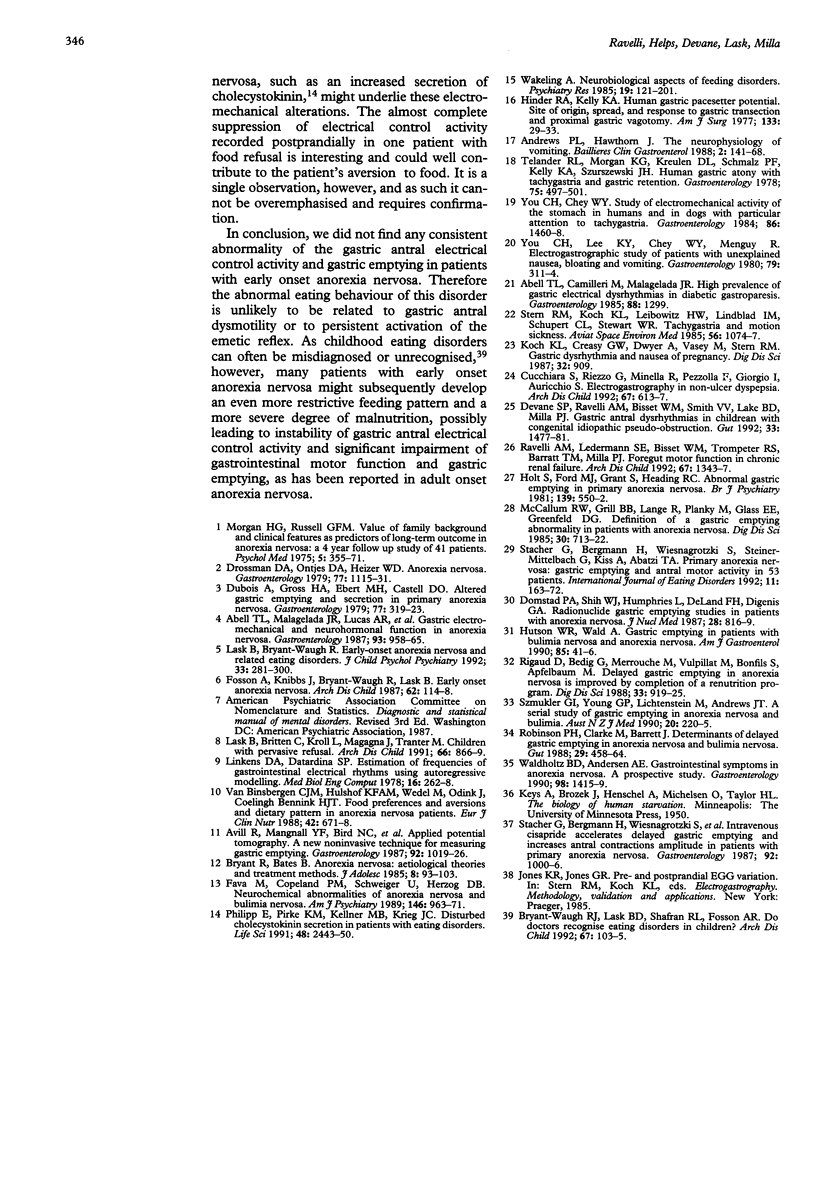
Selected References
These references are in PubMed. This may not be the complete list of references from this article.
- Abell T. L., Malagelada J. R., Lucas A. R., Brown M. L., Camilleri M., Go V. L., Azpiroz F., Callaway C. W., Kao P. C., Zinsmeister A. R. Gastric electromechanical and neurohormonal function in anorexia nervosa. Gastroenterology. 1987 Nov;93(5):958–965. doi: 10.1016/0016-5085(87)90557-9. [DOI] [PubMed] [Google Scholar]
- Abstracts of papers submitted to the American Gastroenterological Association. 86th annual meeting, May 11-17, 1985, New York. Gastroenterology. 1985 May;88(5 Pt 2):1299–1644. doi: 10.1016/S0016-5085(85)80117-7. [DOI] [PMC free article] [PubMed] [Google Scholar]
- Andrews P. L., Hawthorn J. The neurophysiology of vomiting. Baillieres Clin Gastroenterol. 1988 Jan;2(1):141–168. doi: 10.1016/0950-3528(88)90025-5. [DOI] [PubMed] [Google Scholar]
- Avill R., Mangnall Y. F., Bird N. C., Brown B. H., Barber D. C., Seagar A. D., Johnson A. G., Read N. W. Applied potential tomography. A new noninvasive technique for measuring gastric emptying. Gastroenterology. 1987 Apr;92(4):1019–1026. [PubMed] [Google Scholar]
- Bryant-Waugh R. J., Lask B. D., Shafran R. L., Fosson A. R. Do doctors recognise eating disorders in children? Arch Dis Child. 1992 Jan;67(1):103–105. doi: 10.1136/adc.67.1.103. [DOI] [PMC free article] [PubMed] [Google Scholar]
- Bryant R., Bates B. Anorexia nervosa: aetiological theories and treatment methods. J Adolesc. 1985 Mar;8(1):93–103. doi: 10.1016/s0140-1971(85)80010-5. [DOI] [PubMed] [Google Scholar]
- Cucchiara S., Riezzo G., Minella R., Pezzolla F., Giorgio I., Auricchio S. Electrogastrography in non-ulcer dyspepsia. Arch Dis Child. 1992 May;67(5):613–617. doi: 10.1136/adc.67.5.613. [DOI] [PMC free article] [PubMed] [Google Scholar]
- Devane S. P., Ravelli A. M., Bisset W. M., Smith V. V., Lake B. D., Milla P. J. Gastric antral dysrhythmias in children with chronic idiopathic intestinal pseudoobstruction. Gut. 1992 Nov;33(11):1477–1481. doi: 10.1136/gut.33.11.1477. [DOI] [PMC free article] [PubMed] [Google Scholar]
- Domstad P. A., Shih W. J., Humphries L., DeLand F. H., Digenis G. A. Radionuclide gastric emptying studies in patients with anorexia nervosa. J Nucl Med. 1987 May;28(5):816–819. [PubMed] [Google Scholar]
- Drossman D. A., Ontjes D. A., Heizer W. D. Clinical conference. Anorexia nervosa. Gastroenterology. 1979 Nov;77(5):1115–1131. [PubMed] [Google Scholar]
- Dubois A., Gross H. A., Ebert M. H., Castell D. O. Altered gastric emptying and secretion in primary anorexia nervosa. Gastroenterology. 1979 Aug;77(2):319–323. [PubMed] [Google Scholar]
- Fava M., Copeland P. M., Schweiger U., Herzog D. B. Neurochemical abnormalities of anorexia nervosa and bulimia nervosa. Am J Psychiatry. 1989 Aug;146(8):963–971. doi: 10.1176/ajp.146.8.963. [DOI] [PubMed] [Google Scholar]
- Fosson A., Knibbs J., Bryant-Waugh R., Lask B. Early onset anorexia nervosa. Arch Dis Child. 1987 Feb;62(2):114–118. doi: 10.1136/adc.62.2.114. [DOI] [PMC free article] [PubMed] [Google Scholar]
- Hinder R. A., Kelly K. A. Human gastric pacesetter potential. Site of origin, spread, and response to gastric transection and proximal gastric vagotomy. Am J Surg. 1977 Jan;133(1):29–33. doi: 10.1016/0002-9610(77)90187-8. [DOI] [PubMed] [Google Scholar]
- Holt S., Ford M. J., Grant S., Heading R. C. Abnormal gastric emptying in primary anorexia nervosa. Br J Psychiatry. 1981 Dec;139:550–552. doi: 10.1192/bjp.139.6.550. [DOI] [PubMed] [Google Scholar]
- Hutson W. R., Wald A. Gastric emptying in patients with bulimia nervosa and anorexia nervosa. Am J Gastroenterol. 1990 Jan;85(1):41–46. [PubMed] [Google Scholar]
- Lask B., Britten C., Kroll L., Magagna J., Tranter M. Children with pervasive refusal. Arch Dis Child. 1991 Jul;66(7):866–869. doi: 10.1136/adc.66.7.866. [DOI] [PMC free article] [PubMed] [Google Scholar]
- Lask B., Bryant-Waugh R. Early-onset anorexia nervosa and related eating disorders. J Child Psychol Psychiatry. 1992 Jan;33(1):281–300. doi: 10.1111/j.1469-7610.1992.tb00864.x. [DOI] [PubMed] [Google Scholar]
- Linkens D. A., Datardina S. P. Estimation of frequencies of gastrointestinal electrical rhythms using autoregressive modelling. Med Biol Eng Comput. 1978 May;16(3):262–268. doi: 10.1007/BF02442425. [DOI] [PubMed] [Google Scholar]
- McCallum R. W., Grill B. B., Lange R., Planky M., Glass E. E., Greenfeld D. G. Definition of a gastric emptying abnormality in patients with anorexia nervosa. Dig Dis Sci. 1985 Aug;30(8):713–722. doi: 10.1007/BF01320484. [DOI] [PubMed] [Google Scholar]
- Morgan H. G., Russell G. F. Value of family background and clinical features as predictors of long-term outcome in anorexia nervosa: four-year follow-up study of 41 patients. Psychol Med. 1975 Nov;5(4):355–371. doi: 10.1017/s0033291700056981. [DOI] [PubMed] [Google Scholar]
- Phillipp E., Pirke K. M., Kellner M. B., Krieg J. C. Disturbed cholecystokinin secretion in patients with eating disorders. Life Sci. 1991;48(25):2443–2450. doi: 10.1016/0024-3205(91)90379-p. [DOI] [PubMed] [Google Scholar]
- Ravelli A. M., Ledermann S. E., Bisset W. M., Trompeter R. S., Barratt T. M., Milla P. J. Foregut motor function in chronic renal failure. Arch Dis Child. 1992 Nov;67(11):1343–1347. doi: 10.1136/adc.67.11.1343. [DOI] [PMC free article] [PubMed] [Google Scholar]
- Rigaud D., Bedig G., Merrouche M., Vulpillat M., Bonfils S., Apfelbaum M. Delayed gastric emptying in anorexia nervosa is improved by completion of a renutrition program. Dig Dis Sci. 1988 Aug;33(8):919–925. doi: 10.1007/BF01535985. [DOI] [PubMed] [Google Scholar]
- Robinson P. H., Clarke M., Barrett J. Determinants of delayed gastric emptying in anorexia nervosa and bulimia nervosa. Gut. 1988 Apr;29(4):458–464. doi: 10.1136/gut.29.4.458. [DOI] [PMC free article] [PubMed] [Google Scholar]
- Stacher G., Bergmann H., Wiesnagrotzki S., Kiss A., Schneider C., Mittelbach G., Gaupmann G., Höbart J. Intravenous cisapride accelerates delayed gastric emptying and increases antral contraction amplitude in patients with primary anorexia nervosa. Gastroenterology. 1987 Apr;92(4):1000–1006. doi: 10.1016/0016-5085(87)90976-0. [DOI] [PubMed] [Google Scholar]
- Stern R. M., Koch K. L., Leibowitz H. W., Lindblad I. M., Shupert C. L., Stewart W. R. Tachygastria and motion sickness. Aviat Space Environ Med. 1985 Nov;56(11):1074–1077. [PubMed] [Google Scholar]
- Szmukler G. I., Young G. P., Lichtenstein M., Andrews J. T. A serial study of gastric emptying in anorexia nervosa and bulimia. Aust N Z J Med. 1990 Jun;20(3):220–225. doi: 10.1111/j.1445-5994.1990.tb01023.x. [DOI] [PubMed] [Google Scholar]
- Telander R. L., Morgan K. G., Kreulen D. L., Schmalz P. F., Kelly K. A., Szurszewski J. H. Human gastric atony with tachygastria and gastric retention. Gastroenterology. 1978 Sep;75(3):497–501. [PubMed] [Google Scholar]
- Van Binsbergen C. J., Hulshof K. F., Wedel M., Odink J., Coelingh Bennink H. J. Food preferences and aversions and dietary pattern in anorexia nervosa patients. Eur J Clin Nutr. 1988 Aug;42(8):671–678. [PubMed] [Google Scholar]
- Wakeling A. Neurobiological aspects of feeding disorders. J Psychiatr Res. 1985;19(2-3):191–201. doi: 10.1016/0022-3956(85)90017-2. [DOI] [PubMed] [Google Scholar]
- Waldholtz B. D., Andersen A. E. Gastrointestinal symptoms in anorexia nervosa. A prospective study. Gastroenterology. 1990 Jun;98(6):1415–1419. doi: 10.1016/0016-5085(90)91070-m. [DOI] [PubMed] [Google Scholar]
- You C. H., Chey W. Y. Study of electromechanical activity of the stomach in humans and in dogs with particular attention to tachygastria. Gastroenterology. 1984 Jun;86(6):1460–1468. [PubMed] [Google Scholar]
- You C. H., Lee K. Y., Chey W. Y., Menguy R. Electrogastrographic study of patients with unexplained nausea, bloating, and vomiting. Gastroenterology. 1980 Aug;79(2):311–314. [PubMed] [Google Scholar]


